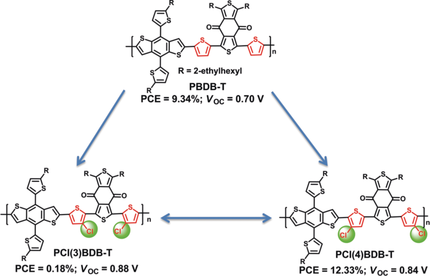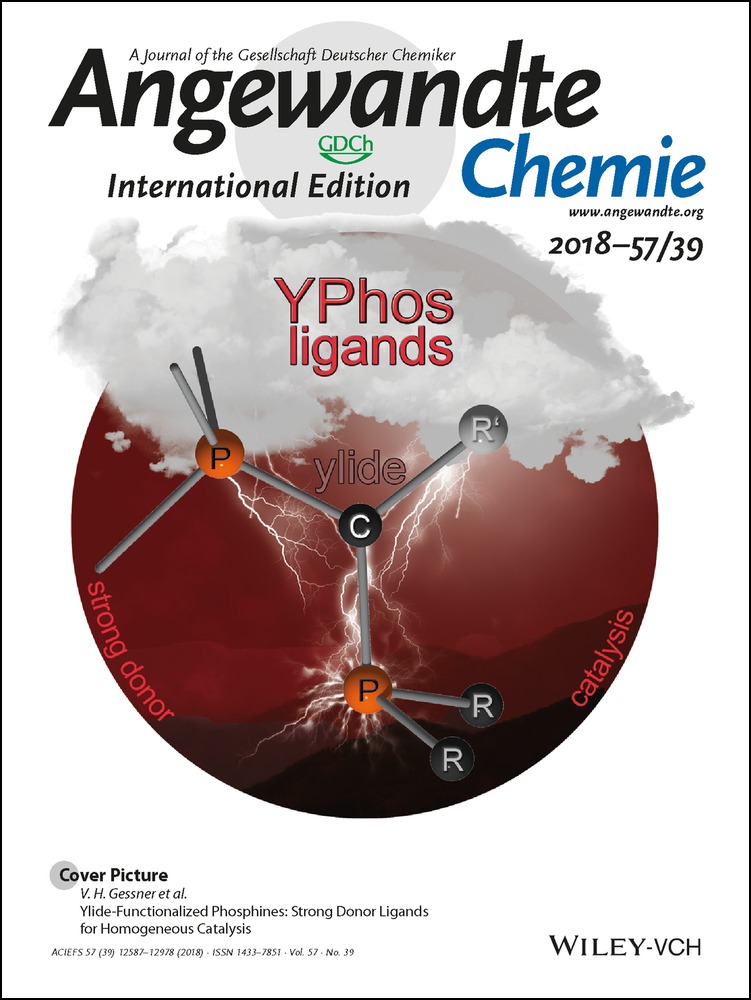The Crucial Role of Chlorinated Thiophene Orientation in Conjugated Polymers for Photovoltaic Devices
Yanan Wu
Beijing National Laboratory for Molecular Science, CAS Key State Key Laboratory of Polymer Physics and Chemistry, Institute of Chemistry, Chinese Academy of Science, Beijing, 100190 P. R. China
Search for more papers by this authorCorresponding Author
Dr. Cunbin An
Beijing National Laboratory for Molecular Science, CAS Key State Key Laboratory of Polymer Physics and Chemistry, Institute of Chemistry, Chinese Academy of Science, Beijing, 100190 P. R. China
Search for more papers by this authorLanlan Shi
Beijing National Laboratory for Molecular Science, CAS Key State Key Laboratory of Polymer Physics and Chemistry, Institute of Chemistry, Chinese Academy of Science, Beijing, 100190 P. R. China
Search for more papers by this authorLiyan Yang
Beijing National Laboratory for Molecular Science, CAS Key State Key Laboratory of Polymer Physics and Chemistry, Institute of Chemistry, Chinese Academy of Science, Beijing, 100190 P. R. China
University of Chinese Academy of Sciences, Beijing, 100049 P. R. China
Search for more papers by this authorYunpeng Qin
Beijing National Laboratory for Molecular Science, CAS Key State Key Laboratory of Polymer Physics and Chemistry, Institute of Chemistry, Chinese Academy of Science, Beijing, 100190 P. R. China
Search for more papers by this authorDr. Ningning Liang
Laboratory of Organic Solids, Institute of Chemistry, Chinese Academy of Science, Beijing, 100190 P. R. China
Search for more papers by this authorDr. Chang He
Beijing National Laboratory for Molecular Science, CAS Key State Key Laboratory of Polymer Physics and Chemistry, Institute of Chemistry, Chinese Academy of Science, Beijing, 100190 P. R. China
Search for more papers by this authorProf. Zhaohui Wang
Laboratory of Organic Solids, Institute of Chemistry, Chinese Academy of Science, Beijing, 100190 P. R. China
University of Chinese Academy of Sciences, Beijing, 100049 P. R. China
Search for more papers by this authorCorresponding Author
Prof. Jianhui Hou
Beijing National Laboratory for Molecular Science, CAS Key State Key Laboratory of Polymer Physics and Chemistry, Institute of Chemistry, Chinese Academy of Science, Beijing, 100190 P. R. China
University of Chinese Academy of Sciences, Beijing, 100049 P. R. China
Search for more papers by this authorYanan Wu
Beijing National Laboratory for Molecular Science, CAS Key State Key Laboratory of Polymer Physics and Chemistry, Institute of Chemistry, Chinese Academy of Science, Beijing, 100190 P. R. China
Search for more papers by this authorCorresponding Author
Dr. Cunbin An
Beijing National Laboratory for Molecular Science, CAS Key State Key Laboratory of Polymer Physics and Chemistry, Institute of Chemistry, Chinese Academy of Science, Beijing, 100190 P. R. China
Search for more papers by this authorLanlan Shi
Beijing National Laboratory for Molecular Science, CAS Key State Key Laboratory of Polymer Physics and Chemistry, Institute of Chemistry, Chinese Academy of Science, Beijing, 100190 P. R. China
Search for more papers by this authorLiyan Yang
Beijing National Laboratory for Molecular Science, CAS Key State Key Laboratory of Polymer Physics and Chemistry, Institute of Chemistry, Chinese Academy of Science, Beijing, 100190 P. R. China
University of Chinese Academy of Sciences, Beijing, 100049 P. R. China
Search for more papers by this authorYunpeng Qin
Beijing National Laboratory for Molecular Science, CAS Key State Key Laboratory of Polymer Physics and Chemistry, Institute of Chemistry, Chinese Academy of Science, Beijing, 100190 P. R. China
Search for more papers by this authorDr. Ningning Liang
Laboratory of Organic Solids, Institute of Chemistry, Chinese Academy of Science, Beijing, 100190 P. R. China
Search for more papers by this authorDr. Chang He
Beijing National Laboratory for Molecular Science, CAS Key State Key Laboratory of Polymer Physics and Chemistry, Institute of Chemistry, Chinese Academy of Science, Beijing, 100190 P. R. China
Search for more papers by this authorProf. Zhaohui Wang
Laboratory of Organic Solids, Institute of Chemistry, Chinese Academy of Science, Beijing, 100190 P. R. China
University of Chinese Academy of Sciences, Beijing, 100049 P. R. China
Search for more papers by this authorCorresponding Author
Prof. Jianhui Hou
Beijing National Laboratory for Molecular Science, CAS Key State Key Laboratory of Polymer Physics and Chemistry, Institute of Chemistry, Chinese Academy of Science, Beijing, 100190 P. R. China
University of Chinese Academy of Sciences, Beijing, 100049 P. R. China
Search for more papers by this authorGraphical Abstract
Abstract
Chlorinated conjugated polymers not only show great potential for the realization of highly efficient polymer solar cells (PSCs) but also have simple and high-yield synthetic routes and low-cost raw materials available for their preparation. However, the study of the structure–property relationship of chlorinated polymers is lagging. Now two chlorinated conjugated polymers, PCl(3)BDB-T and PCl(4)BDB-T are investigated. When the polymers were used to fabricate PSCs with the nonfullerene acceptor (IT-4F), surprisingly, the PCl(3)BDB-T:IT-4F-based device exhibited a negligible power conversion efficiency (PCE) of 0.18 %, while the PCl(4)BDB-T:IT-4F-based device showed an outstanding PCE of 12.33 %. These results provide new insight for the rational design and synthesis of novel chlorinated polymer donors for further improving the photovoltaic efficiencies of PSCs.
Supporting Information
As a service to our authors and readers, this journal provides supporting information supplied by the authors. Such materials are peer reviewed and may be re-organized for online delivery, but are not copy-edited or typeset. Technical support issues arising from supporting information (other than missing files) should be addressed to the authors.
| Filename | Description |
|---|---|
| anie201807865-sup-0001-misc_information.pdf1.8 MB | Supplementary |
Please note: The publisher is not responsible for the content or functionality of any supporting information supplied by the authors. Any queries (other than missing content) should be directed to the corresponding author for the article.
References
- 1
- 1aG. Yu, J. Gao, J. C. Hummelen, F. Wudl, A. J. Heeger, Science 1995, 270, 1789;
- 1bY. Huang, E. J. Kramer, A. J. Heeger, G. C. Bazan, Chem. Rev. 2014, 114, 7006;
- 1cL. Lu, T. Zheng, Q. Wu, A. M. Schneider, D. Zhao, L. Yu, Chem. Rev. 2015, 115, 12666;
- 1dG. Zhang, J. Zhao, P. C. Y. Chow, K. Jiang, J. Zhang, Z. Zhu, J. Zhang, F. Huang, H. Yan, Chem. Rev. 2018, 118, 3447;
- 1eC. Yan, S. Barlow, Z. Wang, H. Yan, A. K. Y. Jen, S. R. Marder, X. Zhan, Nat. Rev. Mater. 2018, 3, 18003;
- 1fG. Li, W.-H. Chang, Y. Yang, Nat. Rev. Mater. 2017, 2, 17043.
- 2
- 2aS. Zhang, Y. Qin, J. Zhu, J. Hou, Adv. Mater. 2018, 30, 1800868;
- 2bS. Li, L. Ye, W. Zhao, H. Yan, B. Yang, D. Liu, W. Li, H. Ade, J. Hou, J. Am. Chem. Soc. 2018, 140, 7159;
- 2cY. Zhang, B. Kan, Y. Sun, Y. Wang, R. Xia, X. Ke, Y. Q. Q. Yi, C. Li, H. L. Yip, X. Wan, Y. Cao, Y. Chen, Adv. Mater. 2018, 30, 1707508;
- 2dY. Cui, H. Yao, C. Yang, S. Zhang, J. Hou, Acta Polym. Sin. 2018, 223;
- 2eX. Che, Y. Li, Y. Qu, S. R. Forrest, Nat. Energy 2018, 3, 422.
- 3
- 3aC. Zhou, G. Zhang, C. Zhong, X. Jia, P. Luo, R. Xu, K. Gao, X. Jiang, F. Liu, T. P. Russell, F. Huang, Y. Cao, Adv. Energy Mater. 2017, 7, 1601081;
- 3bL. Ye, S. Zhang, L. Huo, M. Zhang, J. Hou, Acc. Chem. Res. 2014, 47, 1595;
- 3cB. C. Thompson, B. J. Kim, D. F. Kavulak, K. Sivula, C. Mauldin, J. M. J. Fréchet, Macromolecules 2007, 40, 7425.
- 4
- 4aW. Ma, J. R. Tumbleston, M. Wang, E. Gann, F. Huang, H. Ade, Adv. Energy Mater. 2013, 3, 864;
- 4bI. Osaka, M. Saito, H. Mori, T. Koganezawa, K. Takimiya, Adv. Mater. 2012, 24, 425.
- 5A. Najari, S. Beaupré, P. Berrouard, Y. Zou, J. R. Pouliot, C. Lepage-Pérusse, M. Leclerc, Adv. Funct. Mater. 2011, 21, 718.
- 6
- 6aJ. Min, Z.-G. Zhang, S. Zhang, Y. Li, Chem. Mater. 2012, 24, 3247;
- 6bZ. Chen, P. Cai, J. Chen, X. Liu, L. Zhang, L. Lan, J. Peng, Y. Ma, Y. Cao, Adv. Mater. 2014, 26, 2586;
- 6cS. C. Price, A. C. Stuart, L. Yang, H. Zhou, W. You, J. Am. Chem. Soc. 2011, 133, 4625;
- 6dY. Liang, Z. Xu, J. Xia, S.-T. Tsai, Y. Wu, G. Li, C. Ray, L. Yu, Adv. Mater. 2010, 22, E 135.
- 7M. J. Cho, J. Seo, K. H. Kim, D. H. Choi, P. N. Prasad, Macromol. Rapid Commun. 2012, 33, 146.
- 8D. Zhu, X. Bao, Q. Zhu, C. Gu, M. Qiu, S. Wen, J. Wang, B. Shahid, R. Yang, Energy Environ. Sci. 2017, 10, 614.
- 9
- 9aY. Liu, J. Zhao, Z. Li, C. Mu, W. Ma, H. Hu, K. Jiang, H. Lin, H. Ade, H. Yan, Nat. Commun. 2014, 5, 5293;
- 9bJ. Yuan, M. J. Ford, Y. Zhang, H. Dong, Z. Li, Y. Li, T.-Q. Nguyen, G. C. Bazan, W. Ma, Chem. Mater. 2017, 29, 1758;
- 9cQ. Zhang, M. A. Kelly, N. Bauer, W. You, Acc. Chem. Res. 2017, 50, 2401;
- 9dA. L. Allred, J. Inorg. Nucl. Chem. 1961, 17, 215.
- 10Q. Zhang, L. Yan, X. Jiao, Z. Peng, S. Liu, J. J. Rech, E. Klump, H. Ade, F. So, W. You, Chem. Mater. 2017, 29, 5990.
- 11
- 11aM. L. Tang, Z. Bao, Chem. Mater. 2011, 23, 446;
- 11bM. L. Tang, J. H. Oh, A. D. Reichardt, Z. Bao, J. Am. Chem. Soc. 2009, 131, 3733;
- 11cY.-Q. Zheng, Z. Wang, J.-H. Dou, S.-D. Zhang, X.-Y. Luo, Z.-F. Yao, J.-Y. Wang, J. Pei, Macromolecules 2015, 48, 5570;
- 11dS. Qu, H. Wang, D. Mo, P. Chao, Z. Yang, L. Li, L. Tian, W. Chen, F. He, Macromolecules 2017, 50, 4962.
- 12D. Mo, H. Wang, H. Chen, S. Qu, P. Chao, Z. Yang, L. Tian, Y.-A. Su, Y. Gao, B. Yang, W. Chen, F. He, Chem. Mater. 2017, 29, 2819.
- 13W. Zhao, D. Qian, S. Zhang, S. Li, O. Inganäs, F. Gao, J. Hou, Adv. Mater. 2016, 28, 4734.
- 14D. Qian, L. Ye, M. Zhang, Y. Liang, L. Li, Y. Huang, X. Guo, S. Zhang, Z. Tan, J. Hou, Macromolecules 2012, 45, 9611.
- 15M. P. Maguire, K. R. Sheets, K. McVety, A. P. Spada, A. Zilberstein, J. Med. Chem. 1994, 37, 2129.
- 16L. Huo, S. Zhang, X. Guo, F. Xu, Y. Li, J. Hou, Angew. Chem. Int. Ed. 2011, 50, 9697; Angew. Chem. 2011, 123, 9871.
- 17Z. Fei, F. D. Eisner, X. Jiao, M. Azzouzi, J. A. Röhr, Y. Han, M. Shahid, A. S. R. Chesman, C. D. Easton, C. R. McNeill, T. D. Anthopoulos, J. Nelson, M. Heeney, Adv. Mater. 2018, 30, 1705209.
- 18H. Hu, P. C. Y. Chow, G. Zhang, T. Ma, J. Liu, G. Yang, H. Yan, Acc. Chem. Res. 2017, 50, 2519.
- 19H. Azimi, A. Senes, M. C. Scharber, K. Hingerl, C. J. Brabec, Adv. Energy Mater. 2011, 1, 1162.
- 20W. Li, L. Ye, S. Li, H. Yao, H. Ade, J. Hou, Adv. Mater. 2018, 30, 1707170.
- 21C. An, S. R. Puniredd, X. Guo, T. Stelzig, Y. Zhao, W. Pisula, M. Baumgarten, Macromolecules 2014, 47, 979.
- 22M. J. Frisch. et al., Gaussian 03, Revision B.04: Gaussian, Inc., Pittsburgh PA, 2003.





